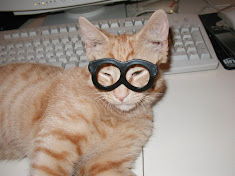The Munchkin
 |
| Short Haired Munchkin by Terri Harris |
In 1990 a study of the genetics of these short legged cats was conducted. The study found that only a single copy of the short legged gene was required to produce more cats with the same characteristic. The spines of these cats were also examined because there were fears that they would have issues like the low, long bodies some dogs (e.g. dachshund) have. Though no problems were found at that time, judgment was reserved due to the extremely small population that existed at that time.
Munchkins were given their name for the little people in Wizard of Oz that Dorothy encountered when she first arrived in Oz. Breeders became interested in the offbeat little Munchkin and began controlled breeding programs. The Munchkin was first introduced to the world at the Madison Square Garden Cat Show. The breed has since faced some resistance. There are those who believe that purposely breeding for a mutation, even one that came about naturally, is ethically wrong. The cats themselves seem unaware that they are different in any way from their long legged cousins. They are self-assured, outgoing and curious by nature. Munchkins tend to be people-oriented and bond easily with their people. Munchkins pounce and play just like other cats. The only difference is they can't jump as high due to their short back legs.
The Sphynx
 |
| Hairless Sphynx Cat by The Pug Father |
This breed sprang up in 1975 as a spontaneous mutation in a shorthaired litter. One hairless kitten was born in that litter. She was named Epidermis. The next year a hairless male was born. He was called Dermis. When bred to normal shorthaired cats, Epidermis produced normal kittens. When Epidermis was bred to one of her sons, three hairless kittens resulted. The hairless gene was a recessive. Both parents must carry it in order for hairlessness to be expressed.
The breed was named after the great Sphynx monument of Egypt. The Sphynx cats are devoted, loyal companions, who love attention and will purr happily if their favorite person is near them. They are very athletic and like to leap to high places or hang upside down from their climbing trees. Sphynx have strong personalities and don't like being left alone. A feline companion will help to keep a Sphynx happy and occupied while you are gone.
These very unique cats are not everyone's ideal cat. Give these very unusual cats a closer look. Their unusual appearances and lively personalities may make a great pet. These cats might be exactly what you are looking for in a new companion.
Author Resource
Written by David Peterson
For more information on cat health issues, visit Jinga's Cat Article site. Visit also Jinga's Pet Article World.
For information on cat breeds visit the House of Jinga
For all your cat needs go to the I Really Love Cats store.
Article From Pet Article World



0 comments:
Post a Comment